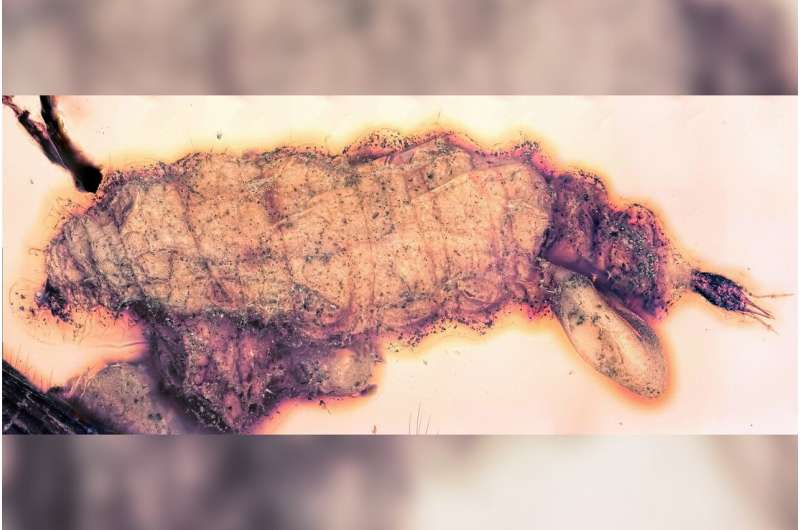Oldest discovery to date of physogastric insects

Trapped in tree resin and preserved as in a time capsule: fossils enclosed in amber yield detailed insights into the anatomy of long extinct species. LMU zoologists Prof. Joachim T. Haug and Dr. Carolin Haug have discovered fossil lacewing larvae (relatives of today's green lacewings) with conspicuously enlarged abdomens. Found in roughly 100-million-year-old amber in Myanmar, the fossils stem from the Cretaceous period. "This is the oldest discovery to date of so-called physogastric insects, which are capable of greatly enlarging their trunk," says Haug.
This phenomenon also occurs in many living insect species and other arthropods. It is based upon a pronounced folding of the external layer of the body, which facilitates a large increase in body volume when required.
In this way, ticks can greatly increase their size when sucking blood and honeypot ants can use their hind body as a voluminous store of nectar for the benefit of the colony. Another example is caterpillars, which devour a lot of food as they go through their larval stages ahead of pupation, quickly gaining body volume in the process.
Specialized predators
In some physogastric species, regular molting is an additional mechanism, allowing even greater enlargement of the trunk. The researchers also found indications of such molting in the fossil larvae from the amber, when they compared their body structure and proportions with living species.
By analyzing morphological features, especially those of the head and the mouthparts, the zoologists were able to identify the fossil larvae as representatives of the group Berothidae (beaded lacewings), an ingroup of Neuroptera (lacewings). As the larvae of some living species spend parts of their larval phase in termite nests, the researchers hypothesize that the fossil larvae may have done likewise.
"Larvae of Berothidae often live in a predatory fashion—parasitical would be another way of describing it—in narrow tunnels and galleries of termite mounds, which would support this conjecture," says Haug. Frequently, physogastry occurs in conjunction with life in confined spaces and is associated with a special predation strategy: "The larvae almost completely fill out the tunnels with their bodies, such that the prey can no longer escape."
Despite these hypotheses about the way of life of the newly found fossil larvae, the reconstruction of their Cretaceous habitat is not yet complete: "Other studies contain many indications of fossil lacewing larvae that lived in dead wood and a handful even point to a fossorial lifestyle in upper soil layers."
Successful evolutionary strategy
What is certain is that physogastry is distributed very unevenly within the arthropods (Euarthropoda), which suggests that this characteristic developed independently multiple times in the course of evolution. Through the discovery of the fossil lacewing larvae, it is now also clear that physogastry must have existed in the evolutionary history of arthropods at least 100 million years ago. This finding represents the oldest evidence of the phenomenon in insects to date.
"Overall, there was evidently greater diversity of forms in the larvae of lacewings during the Cretaceous than is the case today," says Haug. Much of this diversity has since disappeared, and the larvae of most living lacewing species are fast and lean predators. But alongside this mode of being, the strategy of Berothidae has survived: The larvae of this group still develop a considerable corpulence: "This seems to have worked for 100 million years, given that the characteristic of physogastry has survived."
The research was published in Scientific Reports.
More information: Joachim T. Haug et al, 100 Million-year-old straight-jawed lacewing larvae with enormously inflated trunks represent the oldest cases of extreme physogastry in insects, Scientific Reports (2022). DOI: 10.1038/s41598-022-16698-y
Provided by Ludwig Maximilian University of Munich




















